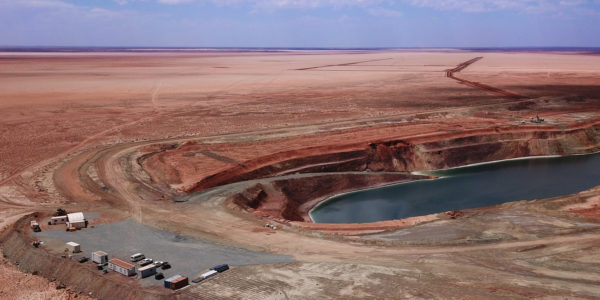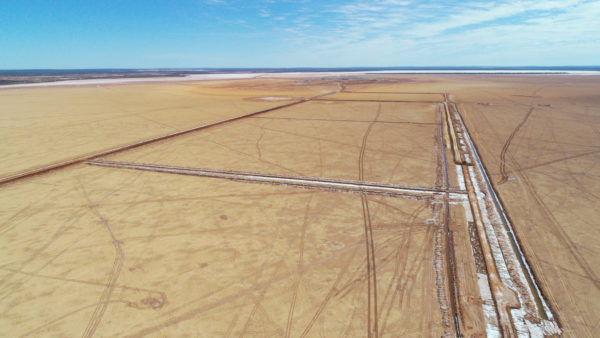|
Sampling Techniques
|
Nature and quality of sampling (e.g. cut channels, random chips, or specific specialised industry standard measurement tools appropriate to the minerals under investigation, such as down hole gamma sondes, or handheld XRF instruments, etc). These examples should not be taken as limiting the broad meaning of sampling.
|
Air-Core samples are composited based on regolith boundaries and sample chemistry, generated by hand-held XRF analysis. Each 1m of sample is dried and riffle-split to generate a total sample weight of 3kg for analysis, generally at 2m intervals. This primary sample is then split again to provide a 1.5kg sample for both rutile and graphite analyses.
Push tube/core drilling is sampled routinely at 2m intervals bounded by weathering contacts by compositing dried and riffle-split half core. A consistent, 1.5kg sample is generated for both the rutile and graphite determination.
|
|
Include reference to measures taken to ensure sample representivity and the appropriate calibration of any measurement tools or systems used.
|
Drilling and sampling activities are supervised by a suitably qualified Company geologist who is present at all times. All drill samples are geologically logged by the geologist at the drill site/core yard.
Each sample is sun dried and homogenised. Sub-samples are carefully
riffle split to ensure representivity. The 1.5kg composite samples are then processed.
An equivalent mass is taken from each sample to make up the composite. A calibration schedule is in place for laboratory scales, sieves and field XRF equipment.
Placer Consulting Pty Ltd (Placer) Resource Geologists have reviewed Standard Operating Procedures (SOPs) for the collection and processing of drill samples and found them to be fit for purpose. The primary composite sample is considered representative for this style of rutile mineralisation.
|
|
Aspects of the determination of mineralisation that are Material to the Public Report. In cases where ‘industry standard’ work has been done this would be relatively simple (e.g. ‘reverse circulation drilling was used to obtain 1 m samples from which 3 kg was pulverised to produce a 30 g charge for fire assay’). In other cases more explanation may be required, such as where there is coarse gold that has inherent sampling problems. Unusual commodities or mineralisation types (e.g. submarine nodules) may warrant disclosure of detailed information.
|
Logged mineralogy percentages, lithology information and TiO2% obtained from handheld XRF are used to determine compositing intervals. Care is taken to ensure that only samples with similar geological characteristics are composited together
|
|
Drilling Techniques
|
Drill type (e.g. core, reverse circulation, open‐hole hammer, rotary air blast, auger, Bangka, sonic, etc) and details (e.g. core diameter, triple or standard tube, depth of diamond tails, face‐sampling bit or other type, whether core is oriented and if so, by what method, etc).
|
A total of 98 Air-Core holes for 2,548m are reported here from drilling at the Kasiya Rutile Deposit to obtain samples for quantitative determination of recoverable rutile and Total Graphitic Carbon (TGC).
A total of 247 push-tube core holes, for 2,205m, were drilled at the Kasiya Rutile Deposit to obtain samples for quantitative determination of recoverable rutile and Total Graphitic Carbon (TGC).
Placer has reviewed SOPs for Air-Core and Core drilling and found them to be fit for purpose and support the resource classifications as applied to the MRE.
|
|
Drill Sample Recovery
|
Method of recording and assessing core and chip sample recoveries and results assessed.
|
Samples are assessed visually for recoveries. The configuration of drilling and nature of materials encountered results in negligible sample loss or contamination.
Air-Core drilling recovery in the top few metres are moderate to good. Extra care is taken to ensure sample is recovered best as possible in these metres. Recoveries are recorded on the rig at the time of drilling by the geologist. Drilling is ceased when recoveries become poor once Sap rock has been encountered.
Core drilling samples are actively assessed by the driller and geologist onsite for recoveries and contamination.
|
|
Measures taken to maximise sample recovery and ensure representative nature of the samples.
|
The Company’s trained geologists supervise drilling on a 1 team 1 geologist basis and are responsible for monitoring all aspects of the drilling and sampling process.
Air-core drilling samples are recovered in large plastic bags. The bags are clearly labelled and delivered back to the laydown at the end of shift for processing.
For push-tube drilling, core is extruded into core trays; slough is actively removed by the driller at the drilling rig and core recovery and quality is recorded by the geologist.
|
|
Whether a relationship exists between sample recovery and grade and whether sample bias may have occurred due to preferential loss/gain of fine/coarse material.
|
No relationship is believed to exist between grade and sample recovery. The high percentage of silt and absence of hydraulic inflow from groundwater at this deposit results in a sample size that is well within the expected size range.
No bias related to preferential loss or gain of different materials is observed.
|
|
Logging
|
Whether core and chip samples have been geologically and geotechnically logged to a level of detail to support appropriate Mineral Resource estimation mining studies and metallurgical studies.
|
Geologically, data is collected in detail, sufficient to aid in Mineral Resource estimation.
All individual 1-metre intervals are geologically logged, recording relevant
data to a set log-chief template using company codes. A small representative sample is collected for each 1-metre interval and placed in appropriately labelled chip trays for future reference.
All individual 1-metre core intervals are geologically logged, recording relevant
data to a set template using company codes.
|
|
Whether logging is qualitative or quantitative in nature. Core (or costean, channel, etc.) photography.
|
All logging includes lithological features and estimates of basic mineralogy. Logging is generally qualitative.
|
|
The total length and percentage of the relevant intersection logged
|
100% of samples are geologically logged.
|
|
Sub-sampling techniques and sample preparation
|
If core, whether cut or sawn and whether quarter, half or all core taken.
|
N/A
|
|
If non-core, whether riffled, tube sampled, rotary split, etc. and whether sampled wet or dry.
|
Air-Core samples are dried, riffle split and composited. Samples are collected and homogenised prior to splitting to ensure sample representivity. ~1.5kg composite samples are processed.
An equivalent mass is taken from each primary sample to make up the composite.
The primary composite sample is considered representative for this style of mineralisation and is consistent with industry standard practice.
|
|
For all sample types, the nature, quality and appropriateness of the sample preparation technique.
|
Techniques for sample preparation are detailed on SOP documents verified by Placer Resource Geologists.
Sample preparation is recorded on a standard flow sheet and detailed QA/QC is undertaken on all samples. Sample preparation techniques and QA/QC protocols are appropriate for mineral determination.
|
|
Quality control procedures adopted for all sub-sampling stages to maximise representivity of samples.
|
The sampling equipment is cleaned after each sub-sample is taken.
Field duplicate, laboratory replicate and standard sample geostatistical analysis is employed to manage sample precision and analysis accuracy.
|
|
Measures taken to ensure that the sampling is representative of the in situ material collected, including for instance results for field duplicate/second-half sampling.
|
Sample size analysis is completed to verify sampling accuracy. Field duplicates are collected for precision analysis of riffle splitting. SOPs consider sample representivity. Results indicate a sufficient level of precision for the resource classification.
|
|
Whether sample sizes are appropriate to the grain size of the material being sampled.
|
The sample size is considered appropriate for the material sampled.
|
|
Quality of assay data and laboratory tests
|
The nature, quality and appropriateness of the assaying and laboratory procedures used and whether the technique is considered partial or total.
|
Rutile
The Malawi onsite laboratory sample preparation methods are considered quantitative to the point where a non-magnetic mineral concentrate (NM) is generated.
Final results generated are for recovered rutile i.e. the % mass of the sample that is rutile that can be recovered to the non-magnetic component of a HMC.
The HMC is prepared via wet-table, gravity separation at the Lilongwe Laboratory which provides an ideal sample for subsequent magnetic separation and XRF.
All samples (incl. QA) included in this announcement received the following workflow undertaken on-site in Malawi;
· Dry sample in oven for 1 hour at 105℃
· Soak in water and lightly agitate
· Wet screen at 5mm, 600µm and 45µm to remove oversize and slimes material
· Dry +45µm -600mm (sand fraction) in oven for 1 hour at 105℃
· Pass +45µm -600mm (sand fraction) across wet table to generate a heavy mineral concentrate (HMC)
· Pan HMC to remove retained light minerals
· Dry HMC in oven for 30 minutes at 105℃
· Magnetic separation of the HMC by Carpco magnet @ 16,800G (2.9Amps) into a magnetic (M) and non-magnetic (NM) fraction.
Bag NM fraction and send to Perth, Australia for quantitative chemical and mineralogical determination.
· The NM fractions were sent to ALS Metallurgy Perth for quantitative XRF analysis. Samples received XRF_MS.
Graphite
All samples are initially checked in and processed to pulp at Intertek-Genalysis Johannesburg.
The pulp samples are then dispatched to Intertek-Genalysis Perth where they undergo TGC assay via method C72/CSA.
A portion of each test sample is dissolved in dilute hydrochloric acid to liberate carbonate carbon. The solution is filtered using a filter paper and the collected residue is the dried to 425°C in a muffle oven to drive off organic carbon. The dried sample is then combusted in a Carbon/ Sulphur analyser to yield total graphitic or elemental carbon (TGC).
The graphitic carbon content is determined by eliminating other carbon forms from the total carbon content. The addition of acid to the sample liberates carbon dioxide thus removing carbonate carbon. Soluble organic carbon will also be removed. Insoluble organic carbon is removed by heating the samples at 425°C in an oxidising environment. The “dried” carbon-bearing sample that is analysed in the resistance furnace is considered to contain only graphitic carbon.
An Eltra CS-800 induction furnace infra-red CS analyser is then used to determine the remaining carbon which is reported as Total Graphitic Carbon (TGC) as a percentage.
|
|
For geophysical tools, spectrometers, handheld XRF instruments, etc., the parameters used in determining the analysis including instrument make and model, reading times, calibrations factors applied and their derivation, etc.
|
Acceptable levels of accuracy and precision have been established. No handheld XRF methods are used for quantitative determination.
|
|
Nature of quality control procedures adopted (e.g. standards, blanks, duplicate, external laboratory checks) and whether acceptable levels of accuracy (i.e. lack of bias) and precision have been established.
|
Sovereign uses internal and externally sourced wet screening reference material inserted into samples batches at a rate of 1 in 20. The externally sourced, certified standard reference material for HM and Slimes assessment is provided by Placer Consulting.
Accuracy monitoring is achieved through submission of certified reference materials (CRM’s).
ALS and Intertek both use internal CRMs and duplicates on XRF analyses.
Sovereign also inserts CRMs into the sample batches at a rate of 1 in 20.
Analysis of sample duplicates is undertaken by standard geostatistical methodologies (Scatter, Pair Difference and QQ Plots) to test for bias and to ensure that sample splitting is representative. Standards determine assay accuracy performance, monitored on control charts, where failure (beyond 3SD from the mean) may trigger re-assay of the affected batch.
Examination of the QA/QC sample data indicates satisfactory performance of field sampling protocols and assay laboratories providing acceptable levels of precision and accuracy.
Acceptable levels of accuracy and precision are displayed in geostatistical analyses.
|
|
Verification of sampling & assaying
|
The verification of significant intersections by either independent or alternative company personnel.
|
Results are reviewed in cross-section using Micromine software and any spurious results are investigated. The deposit type and consistency of mineralisation leaves little room for unexplained variance. Extreme high grades are not encountered.
|
|
The use of twinned holes.
|
Twinned holes are drilled across a geographically dispersed area to determine short-range geological and assay field variability. Twin drilling is applied at a rate of 1 in 20 routine holes.
Acceptable levels of precision are displayed in the geostatistical analysis of twin drilling data.
|
|
Documentation of primary data, data entry procedures, data verification, data storage (physical and electronic) protocols.
|
All geological logging data is collected in LogChief logging software. This data is then imported to Datashed5 and validated automatically and then manually.
Sovereigns’ laboratory data is captured onto paper templates or excel and transferred manually to the database. A transition to electronic laboratory data capture is under investigation.
|
|
Discuss any adjustment to assay data.
|
QEMSCAN of the NM fraction shows dominantly clean and liberated rutile grains and confirms rutile is the only titanium species in the NM fraction.
Recovered rutile is therefore defined and reported here as: TiO2 recovered in the +45 to -600um range to the NM concentrate fraction as a % of the total primary, dry, raw sample mass divided by 95% (to represent an approximation of final product specifications). i.e. recoverable rutile within the whole sample.
|
|
Location of data points
|
Accuracy and quality of surveys used to locate drill holes (collar and down-hole surveys), trenches, mine workings and other locations used in Mineral Resource estimation.
|
A Trimble R2 Differential GPS is used to pick up the collars. Daily capture at a registered reference marker ensures equipment remains in calibration.
No downhole surveying is completed. Given the vertical nature and shallow depths of the holes, drill hole deviation is not considered to significantly affect the downhole location of samples.
|
|
Specification of the grid system used.
|
WGS84 UTM Zone 36 South.
|
|
Quality and adequacy of topographic control.
|
DGPS pickups are considered to be high quality topographic control measures.
|
|
Data spacing & distribution
|
Data spacing for reporting of Exploration Results.
|
The Air-Core holes are spaced on a 200m x 200m grid which is deemed to adequately define the mineralisation.
The Core holes are spaced on a 400m x 400m grid which is deemed to adequately define the mineralisation.
|
|
Whether the data spacing and distribution is sufficient to establish the degree of geological and grade continuity appropriate for the Mineral Resource and Ore Reserve estimation procedure(s) and classifications applied.
|
The drill spacing and distribution is considered to be sufficient to establish a degree of geological and grade continuity appropriate for further future Mineral Resource estimation.
|
|
Whether sample compositing has been applied.
|
Individual 1m intervals have been composited, based on lithology, at a max 2m sample interval for the 98 Air-Core holes and 247 Core holes.
|
|
Orientation of data in relation to geological structure
|
Whether the orientation of sampling achieves unbiased sampling of possible structures and the extent to which this is known considering the deposit type
|
Sample orientation is vertical and approximately perpendicular to the orientation of the mineralisation, which results in true thickness estimates, limited by the sampling interval as applied. Drilling and sampling are carried out on a regular square grid. There is no apparent bias arising from the orientation of the drill holes with respect to the orientation of the deposit.
|
|
If the relationship between the drilling orientation and the orientation of key mineralised structures is considered to have introduced a sampling bias, this should be assessed and reported if material.
|
There is no apparent bias arising from the orientation of the drill holes with respect to the orientation of the deposit.
|
|
Sample security
|
The measures taken to ensure sample security
|
Samples are stored in secure storage from the time of drilling, through gathering, compositing and analysis. The samples are sealed as soon as site preparation is complete.
A reputable international transport company with shipment tracking enables a chain of custody to be maintained while the samples move from Malawi to Australia or Malawi to Johannesburg. Samples are again securely stored once they arrive and are processed at Australian laboratories. A reputable domestic courier company manages the movement of samples within Perth, Australia.
At each point of the sample workflow the samples are inspected by a company representative to monitor sample condition. Each laboratory confirms the integrity of the samples upon receipt.
|
|
Audits or reviews
|
The results of any audits or reviews of sampling techniques and data
|
Richard Stockwell (resource CP) has reviewed and advised on all stages of data collection, sample processing, QA protocol and mineral resource estimation. Methods employed are considered industry best-practice.
Malawi Field and Laboratory visits have been completed by Richard Stockwell in May 2022. A high standard of operation, procedure and personnel was observed and reported.
|









